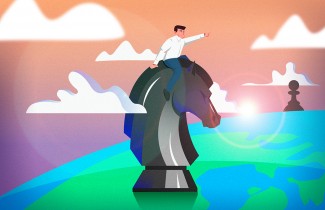The Benefits of Flexible Work in the Post-Covid-19 Era
The Transdisciplinary Flextime Hiring Method (TFHM) considers both employee and company needs

Businesses are always searching for ways to improve their operational efficiency. As is well known, one of the most efficient factors consists of flexible organizational structures. In this context, flexibility is interpreted as the firm’s ability to add or remove scarce and costly resources, such as hiring employees for their knowledge and competences to do highly valuable work.
This flexibilization of the workforce has gained traction during the Covid-19 global pandemic, since businesses have had to face considerable financial pressures to assure their sustainability, as well as health measures that have impacted value delivery conditions, such as on-site work and schedule restrictions. This is particularly true for the service sector where there is an opportunity to hire more people under a scheme of working days with limited hours, in order to increase operational efficiency without losing service quality, while offering part-time jobs to persons in need.
In the service industry, personnel performance is key to achieving business excellence. Until recently, labor contracts of 40 to 48 hours per week with equal daily schedules (8 hours per day) was the only way formal employees were hired in some countries. Lately, this trend has changed, and some countries have started to allow work contracts with less weekly hours and flexible daily schedules. This offers employees some degrees of freedom to work less than 8 hours per day and not necessarily have the same timetable every workday. For their part, employees look for new ways of balancing work and personal needs.
A transdisciplinary method
The forthcoming article “Flexible hiring personnel models to promote human satisfaction and business profit for service industries” proposes a transdisciplinary approach –integrating concepts of optimization, organizational design and minorities inclusion— to reconcile the company’s need to offer a satisfactory service over long working days with employees’ need for work-life balance, affecting their motivation and concentration.
The transdisciplinary approach offers a methodology to tackle this complex problem. According to the International Society of Transdisciplinary Engineering (ISTE), “transdisciplinarity is a methodological approach, explicitly incorporating social sciences to gather information and to guide the implementation of engineering in practice.”
The minimization of hiring costs can be reconciled with employees’ needs by using a mathematical model designed for cost optimization and applying it to the implementation of flextime. Thus, its goal is to improve economic efficiency and thus, increase job satisfaction and retention.
How does Flextime work?
Flexible Work Arrangements (FWAs) are “mutually beneficial arrangements between employers and employees in which both parties agree on when and how the employee will work to meet the firm’s needs.” They define when the workday begins and ends for each employee. There can also be flexibility in performed functions, seeking to enhance employees’ capabilities and skills as a favorable factor for their continuation in the firm.
From the employees’ view, FWAs offer some degree of control over the context in which they work, improving work-life balance, providing job satisfaction, commitment to the organization, productivity and decreased absenteeism.
From the company’s view, FWAs show that the employer is sensitive to its collaborators’ family needs and does not demand the prioritization of work over family. In an environment of talent shortage, more and more companies manage their human capital strategically and employ flexibility as a competitive tool to meet their recruitment objectives.
Implementation of Flextime
Implementing a flextime arrangement in a service-oriented company, where core activities are performed through the direct intervention of qualified employees, is a complex task, but can be simplified.
Traditional operations research (specific quantitative methodologies) offers solutions for workforce scheduling, but does not necessarily address the flexibility workers require or regulatory restrictions. Hence, our transdisciplinary approach.
Some service organizations require customer service for 12, 14 or more hours every day, as is the case of many service establishments, such as convenience, department or grocery stores, bank tellers, cinemas, call centers, service stations, car park or toll-booth attendants, or hotel reception desks, to name a few.
Under the flextime scheme, companies can reduce their payroll significantly, with the additional advantage of an improved work climate and employee commitment. Moreover, employees have the opportunity to work part-time, in blocks of hours or days, giving them time for other family or personal activities.
This opens the door to hiring students, childcare providers, people with disabilities, caregivers for the elderly or sick, and other population segments who need to work but do not have the option of a full-time schedule. In contingencies such as Covid-19, a company can hire people under a scheme of working days with limited hours, or less working days, thus increasing operational efficiency without losing service quality.
Some of the challenges of this model are:
- A greater number of persons on the payroll increases control complexity, although this could be manageable with technology solutions.
- Employee supervision could be more complex.
- It represents a paradigm shift for the company’s management.
The aim of this transdisciplinary model is to promote human satisfaction as a business advantage for service industries.




